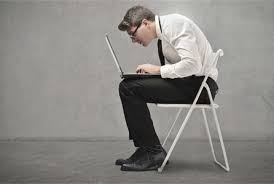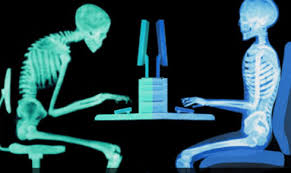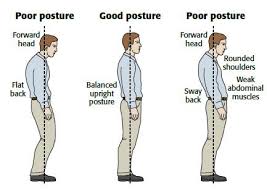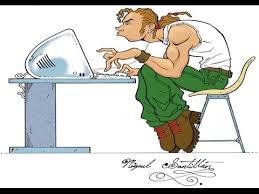


The pictures above show example of good and bad posture.
What I would say though is there is no such thing as a perfect or an ideal posture. What is important to remember is that everybody is different and that goes for posture too however if you look at the pictures above you will be able to see:-
- Picture one – Hopefully nobody thinks that is good. Nobody is like this normally and this will cause you untold issues with pain in the neck, pain in the upper back due to the curvature, back pain due to the fact that your hip flexors are constantly contracted and that you are putting your back on stretch and calf problems due to the fact that your heels are off the floor.
- Picture two -This shows a comparison between good and bad seated postures and what it does to the alignment of the spine when at a desk.
- Picture three – is more about the different types of standing postures although in the first picture on the left – Do you know anybody who stands with their knees bent?
What I’m emphasising is that postures are learnt normaly through poor practices e.g.
- Slouching,
- Sitting at a desk incorrectly,
- Not doing enough exercise,
- Doing the wrong type of exercise. By this I’m talking about doing exercise which doesn’t take into account the way muscles work e.g, Muscles work in opposites – if you’re working your chest, you also need to work your upper back as they work to maintain balance on the upper spine.
What happens with these learnt postures causes some muscles to switch on and other to be constantly contracted e.g. the 1st picture where there is a lot pressure being exerted on the base of the skull. This will cause neck pain and other muscular issues.
I have attached the facebook live that I did last week and you will see near the end of the video some basic exercises that can be done to assist with neck pain.
https://www.facebook.com/WestBerkshireInjuryClinic/videos/337896213447577/
So what can you take from this?
1) Adjust your desk posture to be more like the right hand picture in Picture 2.
2) Don’t sit at your desk fro more than 45 minutes at any one time. Get up, stretch, have a little walk.
3) Make sure you have a lunch break – Go out and get some fresh air! Get a change in scenery.
4) Listen to your body – if you are getting aches and pains then that is your body telling you something is wrong – Do something about it.
5) Get regular exercise – A nice walk, pop to the gym, do some exercise at home, run! Find something you enjoy doing as this is very important to ensure that you continue to do it. But do the right type of exercise and work muscles in balance – don’t just concentrate on your Pecs, work on your upper back to.
If you have any questions then you can get in touch with the clinic. See contact details.

